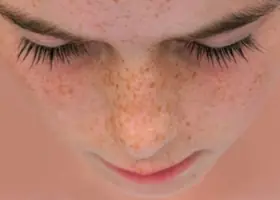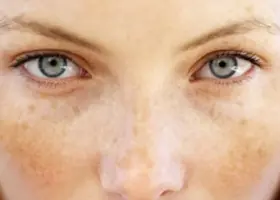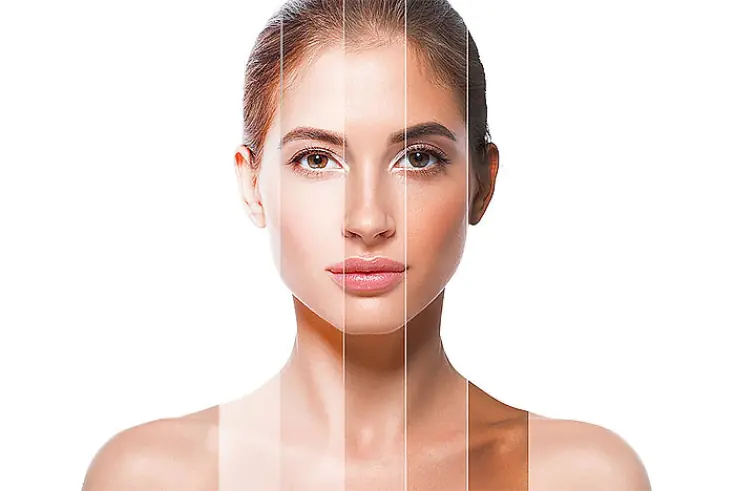
Skin dyschromia - This is a change in the color of human skin. Such violations occur relatively frequently. Sometimes they do not cause discomfort to a person, but in some cases, even in photos, skin dyschromia is easily distinguishable. In such cases, high-quality diagnosis and treatment of skin dyschromia is necessary.
How does a change in skin color manifest itself?
Healthy skin color is due to the presence of four different pigments. Melanin is a brown pigment that is mainly found in the basal layer of the epidermis. Carotene - a yellow pigment that is secreted in the keratinocytes of the epidermis. Red pigment - This hemoglobin, which is saturated with oxygen and is located in capillaries. Blue pigment - this is reduced hemoglobin, which is found in venules.
Changes in skin pigmentation can have different origins. Pigment spots on the skin often appear due to excess melanin production. In more rare cases, age spots on the body are associated with the deposition of other pigments listed above in the skin. Disturbances in skin pigmentation on the arms, legs and other areas of the body can also appear due to exposure to certain external factors. Treatment of such phenomena depends, first of all, on what causes of age spots are detected. The causes of skin pigmentation on the legs, arms and other parts of the body can be associated with both diseases and external influences. For example, age spots on the hands can appear due to exposure to sunlight, etc.
To determine the features and causes of this phenomenon, it is not enough to simply look at a photo or conduct an external examination. During the diagnostic process, specialists identify two types of dyschromia - congenital And acquired. Acquired dyschromia may be primary And secondary.
With dyschromia, it can be noted as hyperchromia (skin hyperpigmentation) and hypochromia (hypopigmentation). Also, skin color may be completely absent (achromia or depigmentation).
If a person suffers from a congenital form of the disease, then color changes may persist throughout his life. If he develops an acquired form of the disease, then the changes disappear after some time or remain forever (this directly depends on the reasons for their occurrence).
Why does skin color change?

The pigment melanin is formed in the skin under the influence ultraviolet. Melanin is produced by cells melanocytes. If the body produces too much melanin, then the body may appear freckles, chloasma, birthmarks, dark spots.
If not enough melanin is produced, a person may suffer albinism, vitiligo.
Freckles (the scientific name for this phenomenon is ephelides) often appear in those people who have a hereditary predisposition to this phenomenon. If during tanning tyrosine is distributed evenly in skin cells, then freckles appear when tyrosine is unevenly distributed, which subsequently turns into melanin.
Freckles appear most clearly in humans at the age of 20-25, and after the age of 35 they become paler. Freckles appear more often in people with red hair and blondes. Freckles are especially noticeable if a person's skin color is white.
Age spots appear on the face in older people. Such formations are sometimes called “senile” lentigo. Their appearance is associated with exposure of the skin to sunlight. These are flat areas of brown skin that appear in most cases on the arms, skin, back, and shoulders. Questions about why such spots appear and what causes skin pigmentation on the face are most relevant for women after 50 years of age. Over the years, the skin becomes thinner and more susceptible to external influences. But sometimes women try to whiten age spots at a younger age. Such spots do not cause harm to health, so drug treatment is not required. However, for reasons of eliminating cosmetic defects that provoke psychological discomfort, face whitening is carried out through various procedures and salon methods.
Chloasma - these are brown spots that appear on the face mainly in women during pregnancy. Chloasma can also change the dull color of the skin with the development of certain diseases of the female genital area, with liver diseases, and with infection by parasites. If such formations merge into one spot, its size can be quite large. As soon as the reason for the appearance of the stain disappears, the formation disappears. That is, after childbirth the woman's face becomes clear again.

Education moles associated with the accumulation of melanocytes on the skin. Most people have moles in varying numbers. They appear on the body from the first years of a baby’s life. More often, such spots appear during periods when a person experiences serious hormonal surges - during puberty, pregnancy, menopause. A more serious health hazard is posed by those birthmarks that did not appear immediately after birth, but at a later age. Such formations often degenerate into melanoma.
Melanoma – This is the most dangerous pigmentation disorder for humans. This is a malignant formation that develops very aggressively. Melanoma grows deep into the skin and spreads further, affecting other organs. Therefore, it is very important to diagnose this disease as early as possible and begin its treatment.
Vitiligo - This is the appearance of colorless areas on the skin due to loss of pigment. The body produces antibodies that attack melonocytes. The only symptom of vitiligo is discolored, pale skin in certain areas of the body. This phenomenon is relatively rare. The causes of pale skin color are due to autoimmune lesions. The disease is associated with a hereditary predisposition.
Pigment spots can appear at the sites of burns, insect bites, scars, scratching, rashes from hives. Changes in skin color are sometimes associated with treatment with certain medications (estrogens, contraceptives), and with dysfunction of the immune system.
After regular tanning under active sunlight or after visiting a solarium, dark areas may also appear on the body.
Changes in skin color can be associated not only with pigmentation disorders, but also with general diseases. For example, the sallow or gray color of a person’s skin clearly indicates that not everything is in order with his health. It should be borne in mind that the types of human skin color may vary due to congenital characteristics. A fairly wide palette of skin tones is considered the norm. What color a person's skin is depends on his genetic characteristics.
But if a person notices that the shade of his skin has changed, the development of the disease can be suspected. First of all, you should determine what natural skin tones he has (color can vary under the influence of tanning, lack of sleep, etc.). You can make an accurate diagnosis and find out the name of the disease only after consulting a doctor.
If the gray complexion of the face has become very noticeable over a short period of time, this may indicate disturbances in the functioning of the digestive system. A sharp change in complexion to grayish is a reason for a visit to a gastroenterologist. An earthy gray tint may indicate disturbances in the functioning of the pancreas. Also, a gray tint to the skin is characteristic of people who smoke a lot and drink alcohol excessively.

Red complexion is a consequence of vasodilatation and active blood flow. This happens to a healthy person staying in hot rooms or in the heat outside. Then the body temperature rises sharply. The face may also turn red due to serious poisoning - toxic, narcotic, alcoholic. However, redness of the face may also be evidence of hypertension and problems in the functions of the cardiovascular system. Your doctor will tell you how to determine the exact diagnosis. In this case, the most important question will not be how to improve your complexion, but the immediate elimination of the cause of redness. A cosmetologist will tell you how to even out your complexion with slight redness, which is associated with the characteristics of the skin.
Those who strive to get an even olive skin color and regularly take sunbathing for this purpose should take into account that ultraviolet radiation aggravates any pigmentation. Therefore, it is very important to always use high-quality protective equipment.
How to get rid of skin discoloration?
If pigmentation appears in a certain area of the body, then you should definitely consult a dermatologist about how to make your skin color even. Even if a person’s pigmentation has changed slightly, simply buying a cream for age spots is not enough. Initially, you need to be examined by a cosmetologist, and if necessary, also visit a dermatologist or therapist.
Whitening creams for age spots contain various substances, in particular, vitamin C, abutin, azelianic acid. Sometimes a cream against age spots contains other ingredients. But it should be noted that their effects can be toxic, so such products must be used very carefully.
Another effective cream for facial pigmentation is a product that contains mercury. However, it is also toxic, so you should initially test whether the cream causes a negative reaction by applying it to a small area of skin for 24 hours. This remedy is not suitable for people with serious illnesses or pregnant women.

You should not use products from unknown manufacturers without first consulting a doctor, for example, some advertised Chinese cream with unreadable instructions and unclear composition. However, the best cream for removing stains can only be recommended by a specialist who will initially determine the cause of changes in skin color.
It is equally important to use a high-quality sunscreen when exposed to direct sunlight. It is important to protect the skin of your face and hands with this product. If there is only mild pigmentation, sometimes all it takes is an exfoliator to remove it.
Laser treatment of pigmentation is often practiced in modern cosmetology. If it is impossible to get rid of discoloration at home, treatment of skin hyperpigmentation is carried out in a salon or clinic. A specialist who provides individual treatment will tell you in more detail about how to get rid of age spots using a laser. Laser removal of pigment spots is carried out using a dosed beam, which is directed to the pigmentation area. After this procedure, the spots become darker for a while, after which they peel off. Laser pigmentation removal on the face is widely practiced; this method also removes severe post-traumatic pigmentation on all parts of the body. Laser treatment cannot be practiced in acute infectious diseases, pregnancy, or in the presence of an inflammatory process at the site of pigmentation. This procedure is relatively painless, and the treated areas heal quickly.
Other methods of removing such stains are also practiced: freezing, photo removal (removal with photoflash), elimination of pigmentation with folk remedies, etc.
However, the decision on how to remove age spots cannot be made on your own. The most effective procedures will always be those prescribed by a specialist.
In the process of most whitening procedures, two stages of exposure are practiced. Firstly, it ensures exfoliation of the stratum corneum of the skin, and secondly, it slows down the production of melanin. For exfoliation, peeling is practiced, which helps dry out the skin. As a result, she ages more rapidly. Therefore, it is imperative to take care of hydration.
Moles are usually removed only if there are specific medical indications. It is advisable to remove moles only if they are a serious cosmetic defect. However, undamaged, sharply enlarging moles need to be paid close attention, as there is a risk of their degeneration into malignant formations. In this case, the examination should be carried out immediately. Melanoma is a serious disease that requires immediate treatment. It should be noted that pigmentation, which is a symptom of a certain disease, cannot be eliminated until the cause of its occurrence is determined. After this, treatment for the underlying disease is prescribed. In this case, whitening procedures are usually useless.
Any change in skin tone, if it did not occur under the influence of sunlight, is a serious signal about a disruption in the functioning of internal organs.
So, for example, if the functioning of the gastrointestinal tract is disrupted, the shade of the face may change from healthy to gray; it may turn blue if there is impaired blood circulation, diseases of the cardiovascular system or respiratory failure; in addition, a purple tint indicates congenital heart disease, and a yellow hue indicates liver diseases.
Gray facial skin - a disease or a consequence of bad habits
A sudden and noticeable change in complexion tone from natural and healthy to gray is most often a sign of a malfunction digestive system. At best, your face may turn gray due to banal constipation or poor nutrition, at worst, due to gastritis or the development of a stomach ulcer. It is hardly possible to independently diagnose the disease on the basis of dyschrony alone, so in this situation it is better to go to an appointment with a gastroenterologist.
In addition, gray facial skin does not always portend illness. Often, against the background of smoking, sedentary work and constant stress, people's blood circulation is impaired and blood vessels narrow, which is also manifested by a deterioration in complexion.
Earthy tint and sharp darkening of the skin - pancreatic disease or oncology
Changes of this kind indicate more serious illnesses. Often, of course, an earthy tint appears due to diseases of the pancreas, adrenal glands, or against the background of long-term use of antibiotics, but if such options are excluded, then the best recommendation in this case would be to turn to modern medicine. Diagnosis of the disease by the skin and on the basis of examinations will allow you to correctly and accurately determine the cause of the change in complexion, as well as timely diagnose the disease that provoked it.
Blue skin color – cyanosis disease
The skin acquires a bluish and sometimes dark purple tint when the blood is insufficiently oxygenated and blood circulation slows down. Such symptoms indicate cyanosis, a disease that combines many disorders of the cardiovascular and respiratory systems.
It happens that cyanosis occurs due to hypothermia. Then, mainly the limbs acquire a blue tint as a result of deterioration of blood circulation in the damaged areas.
Bruises on the skin – diseases of the cardiovascular and respiratory systems
It is in the form of the formation of bluish areas and bluish areas of the mucous membranes that diseases such as heart disease and gas exchange disorders in the lungs make themselves felt. Such changes, however, can provoke the formation of methemoglobin against the background of intoxication and poisoning.
Cyanosis - purple skin disease
The appearance of dark shades or spots on the face and body (purple or cast iron color) indicates increased airiness of the lungs, pulmonary artery sclerosis or congenital heart disease. In any case, if you notice any of the above symptoms, you should immediately consult a doctor.
Vasculitis is a disease of blood vessels in the skin.
This disease involves damage to the blood vessels and tissues of the damaged organ. If the skin vessels are affected, the main symptoms of the disease will be redness, rash and itching. Vasculitis can also affect the circulatory system of the brain, which causes a stroke, the heart, which increases the risk of heart attack, etc., quite often small hemorrhages under the skin are a sign of vasculitis of other organs.
The main symptoms of this disease include: general weakness, fever, loss of appetite, weight loss, rash and itching, joint pain.
A similar syndrome can also occur with systemic lupus erythematosus, rheumatoid arthritis and other diseases characterized by damage to connective tissue.
Cuperosis is a vascular skin disease
Couperosis appears in the form of small red vascular mesh or so-called “spiders” on the cheeks, chin and nose when the blood vessels dilate against the background of increased blood circulation. At the same time, the connective tissue squeezes the vessels from the outside, which makes them more visible on the face. This disease occurs among older people, as well as among those with thin and sensitive skin.
Couperosis can be treated either in a cosmetology salon or using traditional methods. Although the first method allows you to get rid of the signs of rosacea in the shortest possible time. But in case of lack of funds or opportunities - facial massage. This way you can normalize blood circulation and tone the blood vessels and muscles of the face. In addition, supplement your diet with foods or dietary supplements rich in vitamins C, P, K, antioxidants, Omega 3 and 6 fatty acids - they strengthen the walls of blood vessels and help normalize blood circulation.
Yellow skin – liver disease
Most often, yellowing of the face and body is accompanied by a change in the shade of the eye sclera, mucous membranes, especially under the tongue, feet and palms. At the same time, the color of the urine changes - it acquires a rich dark shade.
Such changes most often occur against the background of increased levels of carotene or bilirubin. In the first case, the skin can become yellow if you follow a diet consisting of oranges or carrots for a long time. If these did not occur, then most likely the matter is an increase in the content of bilirubin - a bile pigment that appears as a result of the breakdown of hemoglobin. The latter is responsible for saturating the blood with oxygen and transporting nutrients not only to skin cells, but throughout the body. When there is a decrease in hemoglobin and an increase in bilirubin, changes occur not only in the layers of the dermis, but also in the liver. Then there is a risk of jaundice. In addition, yellowness may indicate diseases such as hepatitis, cirrhosis of the liver, the formation of cysts, as well as disorders of the gallbladder and biliary tract.
Our face is an attribute of our health. Violation of the integrity of the body and the functioning of any organ inevitably leads to imprinting the condition on the face.
And we are not talking about facial expressions of emotions that appear in case of pain or discomfort. There is a change in the color of the skin on the face due to some pathological processes. It is often a person's own fault that the skin becomes pale, sallow or gray.
The reasons for this appearance can be as simple as poor sleep and ending with serious health problems. In this article we will look at the reasons for changes in skin color and methods for eliminating this defect in appearance.
5 reasons that cause skin discoloration
Human skin performs many functions; it contains many nerve endings that connect it with many organs and systems, and most importantly, with the brain. Therefore, the color of the skin depends on the coordinated work of all organs.
If you notice that your skin color changes towards yellow, blue, earthy or green, you should consult a doctor immediately. Such changes mean the presence of severe pathological processes in the body, which is life-threatening.
If your complexion can be described as reddish, pale or dull, reconsider your diet, habits, daily routine, measure your pulse, temperature and blood pressure.
Causes of unhealthy skin color
Reason #1 – Gastrointestinal dysfunction
Indigestion has a particularly detrimental effect on complexion. With constipation, stool accumulates, which contributes to the spread of toxic substances throughout the body. If you have persistent stomach upsets, this problem also causes changes in skin color. Pay attention to the sounds during the digestion of food, the frequency of trips to the toilet, the feeling of pain or heaviness in the intestines, and flatulence. If you experience discomfort, you should visit a gastroenterologist and undergo an examination.
To ensure that your stomach and intestines are always normal, eat oatmeal with dried apricots, raisins, apples and honey for breakfast. Such a healthy breakfast will improve your metabolism and normalize the functioning of the gastrointestinal tract and excretory system.
Reason No. 2 – Improper daily routine and lack of sleep
Lack of sleep or insufficient sleep has a detrimental effect on both your well-being and the skin tone on your face. In addition to changes in skin color, bags under the eyes, dark circles, and drooping cheeks appear. The body needs 6-8 hours of sleep depending on circadian rhythms. Moreover, you should not only sleep a certain number of hours, but also establish a sleep-wake schedule. If you go to bed after 23.00 and sleep until lunch, this is also not good for the general condition and color of the skin. The best time to go to bed is 22.00 or 23.00.
Reason #3 – Lack of oxygen
Poorly ventilated indoor air provokes health problems. The reason for everything: lack of oxygen. The pulmonary system does not receive enough oxygen, even less of it enters the blood, and only a tiny dose enters the brain. This may cause dizziness, weakness, yawning, sleepiness, and as a result, gray and dull skin color.
Ventilate the room every day before going to bed. At work, don’t sit inside the office all day, take a 20-minute walk down the street. Return from work on foot, at least a few stops. Breathe deeply, straightening your shoulders.
Reason No. 4 – Improper nutrition, incorrect diet
Among other things, a passion for sweets or starchy foods leads to overload of the stomach and intestines, which is fraught with digestive disorders. And as a result, disruptions during the functioning of the stomach and intestines are visible on the face - the color of the skin changes, acne and redness may appear. Alcohol also has a detrimental effect on the color of the skin, poisoning the epidermis and dermis with toxic substances.
In addition, improper eating patterns can cause paleness and a gray complexion. Lack of breakfast and a full lunch, overeating in the evening, or lack of food throughout the day and a large dinner - all this can lead not only to changes in skin color, but also to the appearance of puffiness.
Adjust your diet, adapt your food intake to your daily routine - and a fresh complexion will always please you.
Reason #5 – Bad habits
There is such a thing as “smoker’s syndrome” or “smoker’s face”, by the characteristic signs of which one can recognize the presence of a bad smoking habit. The main distinguishing features: grayish and dull skin tone, premature wrinkles, dry skin, sunken cheeks, deeply pronounced nasolabial folds. Cigarette smoke increases the amount of carbon monoxide in the blood and provokes capillary spasm. The skin does not receive enough essential microelements and loses turgor and moisture. Thus, there is a change in skin color and structure: dryness, sagging, premature aging.

If you are not satisfied with the color of your skin and the health associated with smoking, give up this habit and consume more products that help eliminate toxins and nicotine.
How to restore healthy skin color
Let's look at the basic recommendations on how to restore skin color and maintain a healthy glow:
- move more;
- get enough sleep;
- do not forget about morning exercises;
- eat healthy foods;
- don’t forget about vitamins;
- drink at least 2 liters of water per day.
Follow expert advice on how to restore your complexion. Estet-portal.com recommends eliminating the factors that provoke changes in skin color to improve your appearance and well-being.



